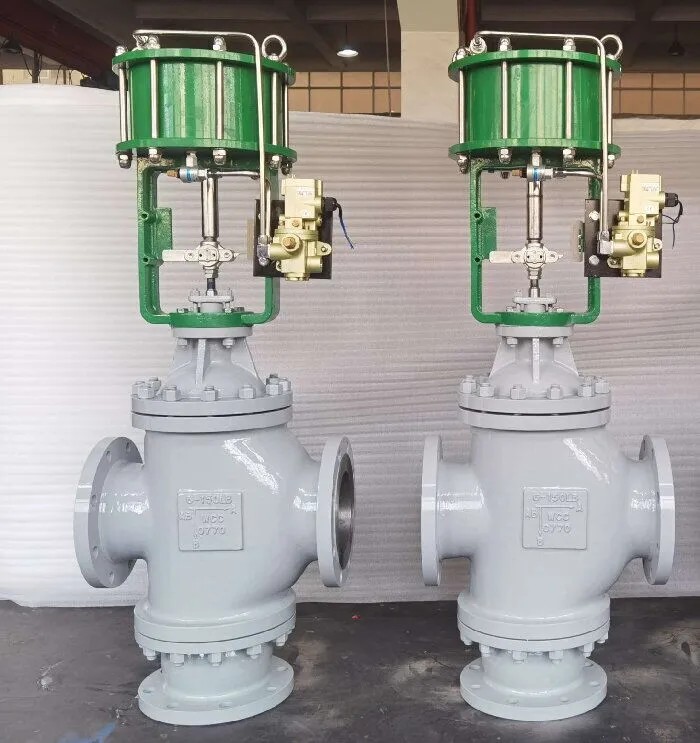Introduction
Pneumatic three-way China control valves are essential components in industrial fluid control systems, designed to manage and regulate the flow of media such as water, steam, or gas. Engineered for either mixing or diverting functions, these heavy-duty valves offer versatile and precise flow management solutions across a wide range of industries. Commonly implemented in heat control systems for heat exchangers and other thermal management processes, pneumatic three-way control valves are valued for their reliability, accuracy, and efficiency.
The actuator mechanism typically features a compact, multi-spring diaphragm motor, providing robust performance even under high differential pressures. This streamlined design simplifies operation while ensuring dependable control in demanding industrial environments.
Key Specifications
Specification Without Positioner With Positioner Hysteresis Error Within 3% F.S. Within 1% F.S.Linearity±5% F.S.±1% F.S.
These metrics demonstrate the valve’s ability to maintain consistent accuracy, particularly when paired with a positioner.
How Does a Pneumatic Three-Way Control Valve Work?
Pneumatic three-way control valves operate by using compressed air to actuate the valve’s internal components. The valve features three ports — either one inlet and two outlets or two inlets and one outlet, depending on the application. The pneumatic actuator moves the valve plug or spool, controlling whether the flow is diverted between outlets or combined from inlets.
The multi-spring diaphragm motor converts the pneumatic signal into precise mechanical motion, allowing smooth valve positioning under high-pressure differentials. This reliable mechanism is particularly beneficial in systems like heat exchangers, where precise temperature regulation is critical. For example, in a diverting application, the valve can channel hot water to a heating circuit or bypass it to a cooling system as required.
Benefits of Pneumatic Three-Way Control Valves
- Versatility: Suitable for water, steam, and gas applications, handling both diverting and mixing tasks efficiently.
- Precision: Exceptional control accuracy with low hysteresis and tight linearity, especially when combined with a positioner.
- Durability: Designed for heavy-duty operation, capable of withstanding high differential pressures and harsh environments.
- Compact Design: The small diaphragm motor reduces the overall size and weight, simplifying installation and maintenance.
- Energy Efficiency: Optimizes flow control to reduce energy consumption in HVAC and other thermal management systems.
- Ease of Maintenance: Simplified operating mechanisms minimize wear and reduce downtime.
Maintenance Guidelines
Maintaining pneumatic three-way control valves ensures long service life and reliable performance:
- Regular Inspection: Check for signs of wear, corrosion, or damage to diaphragms, seals, and actuators.
- Lubrication: Properly lubricate moving parts to minimize friction and wear.
- Cleaning: Remove debris or mineral buildup that could obstruct valve movement.
- Calibration: Periodically calibrate the valve and positioner to maintain control accuracy.
- Leak Detection: Inspect for air or fluid leaks and promptly address any found.
- Parts Replacement: Replace worn or damaged seals and diaphragms as needed.
Recommendation: Choose a two-way valve for basic flow regulation or on/off control. Opt for a three-way valve when your system requires mixing, diverting, or precise thermal management.
Typical Applications
- HVAC Systems: For regulating heating or cooling media flow, ensuring efficient temperature control.
- Heat Exchangers: Managing hot or cold fluid flows to maintain desired temperature levels.
- Industrial Processes: Diverting or mixing fluids in manufacturing lines to meet process specifications.
- Water Treatment: Controlling chemical and water flows to optimize treatment efficiency.
- Steam Systems: Regulating steam flow for heating or power generation purposes.
Conclusion
Pneumatic three-way control valves provide precise, durable, and versatile flow management solutions essential for modern industrial systems. Whether deployed in HVAC, heat exchangers, or complex process controls, their robust design and advanced control capabilities ensure reliable performance even in demanding environments.
Understanding their working principles, benefits, and maintenance needs allows you to maximize valve lifespan and system efficiency. Furthermore, by evaluating your application requirements and comparing two-way and three-way valves, you can select the optimal valve solution to meet your operational goals.
Investing in high-quality pneumatic three-way control valves is a prudent choice for industries aiming to enhance flow control precision, energy efficiency, and system reliability. Know more about Google SEO Directory





Comments